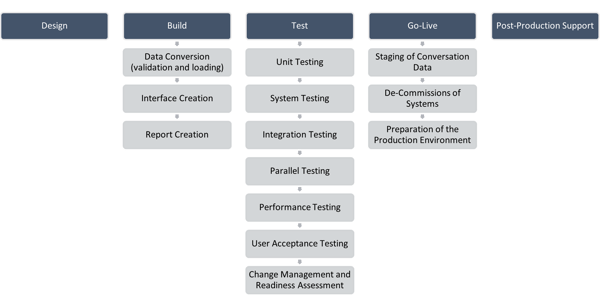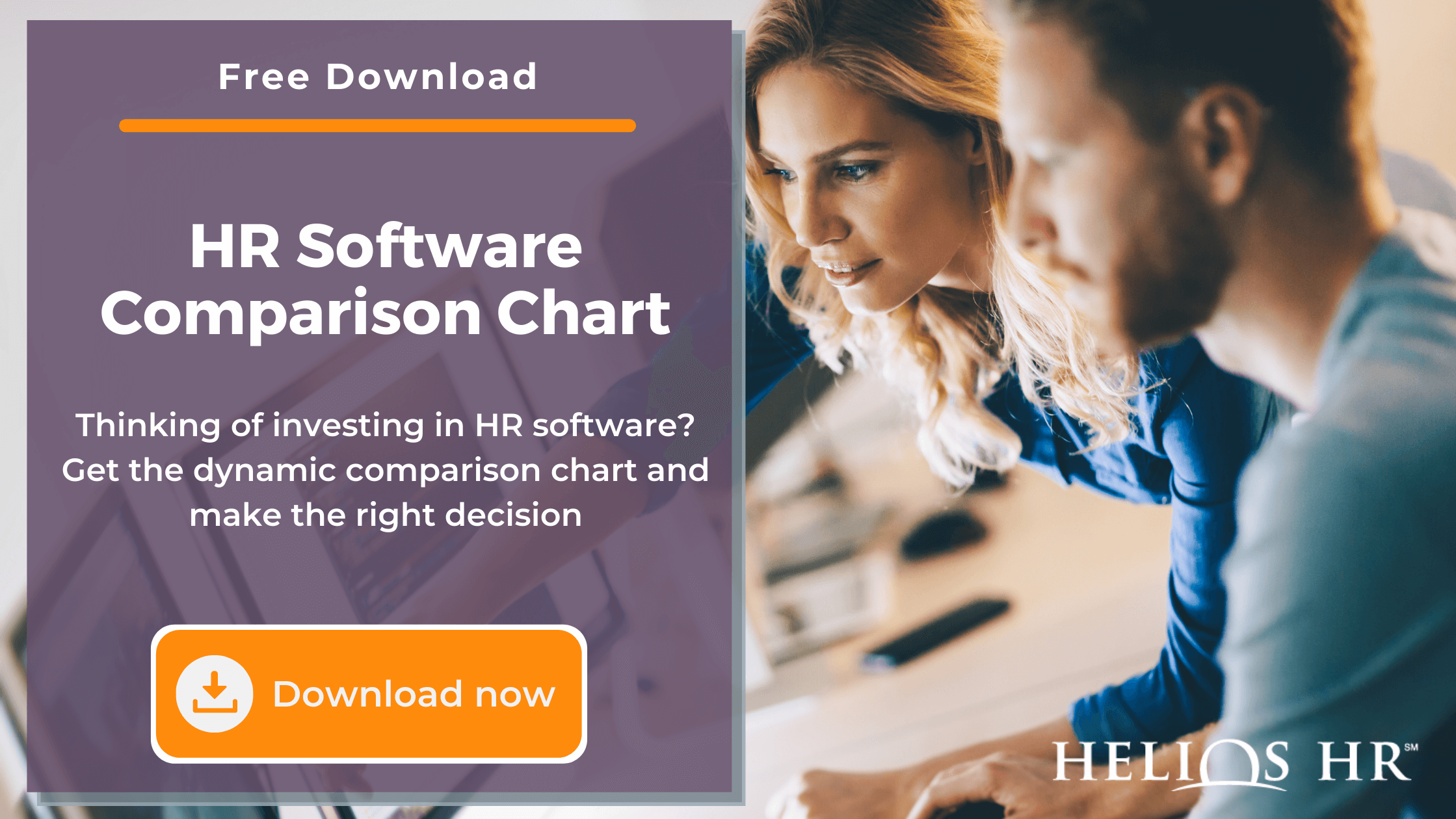By: Cindy Najera on April 26th, 2023
How to Solve Common HRIS Implementation Problems
Taking on a large initiative like a Human Resource Information System (HRIS) system selection and/or implementation can be daunting to many businesses. Fear of the unknown, the heavy lift of the project, and thinking about what can go wrong can keep employers from tackling this important initiative.
“HR Technology is harder to implement than ever," said world-known industry analyst and author, Josh Bersin. (Bersin, 2019)
 The biggest piece of advice I can share is as your company embarks on an HR system selection and/or HRIS implementation plan, set realistic expectations for what success looks like. Problems are going to happen, and there are ways you can mitigate them.
The biggest piece of advice I can share is as your company embarks on an HR system selection and/or HRIS implementation plan, set realistic expectations for what success looks like. Problems are going to happen, and there are ways you can mitigate them.
As an HRIS consultant, my team and I get asked by HR professionals how they can have a smooth HRIS implementation and avoid problems. In this article, I've included some helpful tips that we have used with our clients to provide the smoothest implementation possible with your new HR system.
What is an HRIS Implementation?
An HRIS implementation is the critical process of designing, building, testing, and rolling out a new platform that integrates HR processes and technology. Below is a chart created by the International Association for Human Resource Information Management (IHRIM) that details the HRIS implementation phases and what is typically included within each phase.
HRIS Implementation Phases

Source: IHRIM
Each software vendor will have its own methodology, and some are much more flexible than others. Regardless of the specific methodology, HRIS software implementations consist of the five phases outlined:
- Design
- Build
- Test
- Go-Live
- Post-Production Support
Companies must understand the level of effort and requirements needed during their implementation. We recommended that you obtain everything in writing from the HRIS vendor related to their role during the implementation and fully understand what your organization’s role will be in the process.
Based on our experience, there are a few common pitfalls that we help our clients through during the system selection and implementation process.
3 biggest challenges with HRIS implementation
Challenge #1: Time & Dedication
Time can be a deterrent for a large initiative like an HR system implementation. Most commonly it's because the team doesn't realize how much time is needed or their schedules don't allow sufficient time to dedicate to the project. Leaders need to work with their HR departments and the identified HRIS vendor to set realistic time frames.
New HR system implementations take time to ensure they are rolled out correctly. This is not to say that you cannot complete implementation within your identified timeline; however, companies must be willing to dedicate the resources needed to meet the identified timeline.
We often see clients that have set goals to implement new HRIS systems in less than 12 weeks, and although doable (depending on your resources), they did not fully understand how much time will be needed from their HR team and leadership.
We have supported clients through simple and complex HRIS implementation projects and recommend the following tips:
- Establish a Core HRIS Project Team and allow them to have the recommended time needed for the project (the exact amount of time will depend on the complexity of the human resource management system being implemented and will vary by the organization). The Core Project Team is comprised of the Project Sponsor (Senior Leadership), HR department, IT department liaisons, the Vendor’s implementation team. If you have partnered with a third-party firm, they will be heavily involved throughout the project.
- Map out your current HR Functional Processes/Workflows and where the gaps are. This can be in the form of a workflow in Visio or mapped out in MS Word or Excel. This step is key to understanding what functionality you need out of your new HR system. We assist our clients through this process during the HRIS system selection phase, which aids in identifying potential vendors based on the functionality needed for the company. Having the process outlines/workflows prepared ahead of time will allow the implementation phase to run much smoother.
- Process outlines/workflows are essentially documented outlines of the various processes by functional area, including all steps from start to finish. Each HR functional area should be broken down for them within your organization. The process outlines that we create for our clients include:
- Step
- Task/Function
- Resource 1 (Initiator)
- Resource 2 (Receiver)
- Current System/Manual
- Automation Capabilities
- Gaps
- Considerations
- Each HR functional area should break down the process outlines/workflows for your Organization:
- Recruiting
- Onboarding
- Benefits (new hire, annual open enrollment, live events, termination)
- Payroll
- Performance Management
- Compensation (merit increases/bonuses)
- Termination
- Process outlines/workflows are essentially documented outlines of the various processes by functional area, including all steps from start to finish. Each HR functional area should be broken down for them within your organization. The process outlines that we create for our clients include:
- Identify Core Modules/Components that must be implemented by the Go-Live date.
- Many of the HR platforms in the market have robust features and capabilities. It is not realistic for organizations to implement all the modules offered by the vendor simultaneously. Instead, we recommended taking a phased approach to the implementation and roll-out of the modules available. Your selection will be based on your business needs and the problems you are looking to resolve or streamline.
- The process outline/workflow can assist your company in making this determination. Which functional areas are causing the most significant concern (whether it is the manual entry or continuous corrections that have to be made)? Focus on these areas first, and then you can look at how you can continue to enhance the system by adding additional modules in the future 6 to 12 months after your initial Go-Live.
- The Core modules that we often recommended implementing first are:
- Core HR (employee data)
- Payroll
- Recruiting
- Onboarding
- Performance Management
- Benefits
- Many of the HR platforms in the market have robust features and capabilities. It is not realistic for organizations to implement all the modules offered by the vendor simultaneously. Instead, we recommended taking a phased approach to the implementation and roll-out of the modules available. Your selection will be based on your business needs and the problems you are looking to resolve or streamline.
Challenge #2: Data Integrity
You've heard the saying, “Garbage In, Garbage Out.” Data integrity is critical.
One of the reasons your company may have opted for a new or enhanced HR system is from the data perspective. Employers who do not have HR systems to store core employee data often find they are housing data in multiple places.
We often see most of the HR data housed in either the timekeeping/accounting system, excel, or even the benefits platform. With employee data housed in various places, it is often difficult to determine which system has the most accurate information.
It's not always practical to perform an HR data migration to a centralized repository, so we recommend that you pick the most accurate data sources, then merge and clean up that data. We recommend auditing your data when you are going through your system selection or identifying the platform you will be implementing.
You want to have clean data at the beginning of your HRIS implementation. This is one of the first things imported into your new HR system (check out the Implementation Phases above for reference). The internal HR department should be best positioned to take on this part of the project plan as they are the ones most intimate with the core data.
Challenge #3: Adoption
Successful implementation of an HR technology project ends with user adoption, but this isn't always a given. Early communication and buy-in from the managers are essential if you want all team members to use your new software solutions.
You want to ensure you are communicating how the new system will help them and their employees. If there is no benefit to them or their employees, they will not be on board, and you will struggle with adoption.
If managers and employees do not adopt your new HR system, you will continue processing requests and pulling data for them. You want to empower and show them what they will be able to do without waiting for HR.
Each employer handles buy-in and adoption differently and is typically based upon the organizational culture. We have worked with clients that:
- bring in senior leadership and key managers into the HR system selection conversation.
- include senior leadership in conversations surrounding broken HR processes, challenges they face with employee data, and what they would like to see in a new HR system. (This is not a negative; you are implementing a new HR system for a reason; take it as an opportunity to seek as much feedback as you can. This will ensure full adoption across the entire company.)
- or include key managers when mapping out their HR functional processes and ask similar questions.
Managers are included during these conversations since processes could be slightly different for each department. Potential questions to ask senior leaders and managers are:
- What is not currently working properly, in your opinion, related to employee data and HR processes?
- Which HR processes are broken that could potentially be fixed by an HR system?
- What challenges are you experiencing as it relates to employee data?
- What would you like to see from a new HR system?
Related reading: The Complete Guide to HRIS and HR Software
Additional HRIS Implementation Challenges Employers Experience
There are many implementation challenges that an organization could face and within this article, we highlighted the top three that our clients encounter. Here are some additional challenges that you could experience during your HR implementation to be aware of below.
Challenge #4: Identifying and Assigning Security Roles
Security is extremely important as you are housing highly sensitive data on your employees (social security numbers, payroll information, and in some cases, medical information). During the implementation of new HR tech, organizations must establish security measures to ensure only authorized users access the application and that the information they can see is relevant to their position.
The process of identifying and assigning security roles is one that requires thought and consideration into what each role needs to perform their duties. Best practice is to use Role-Based Security, this assigns permission to the system based on the role(s) a person performs. This strategy designs roles around HR functional processes (payroll, benefits, compensation). Permissions to access and update information in the HR system is assigned to these functional roles.
Role-Based security eliminates the need for management of individual user rights and simplifies the security maintenance process within your HR system.
Challenge #5: Lack of Project Clarity (HRIS Strategy)
HRIS Strategy is the roadmap for how your HR processes and HR leadership are supported using HR technology. This HRIS strategy is the core foundation and framework that will guide your organization through the system selection and implementation of the selected HR platform.
The HRIS strategy looks at the holistic picture of the business to identify what the complete needs are, and without this, you could end up with a siloed system that does not support the entire company. The digital HR management strategy should have clear goals and well-defined metrics for success.
Challenge #6: Poor Project Management
Project management is critical to achieving a successful HRIS implementation and includes directing the scope, schedule, and resources involved in project activities. It takes an investment in planning and organization to make your HR implementation process work. The project manager is responsible for effectively managing expectations by publishing regular status reports.
At Helios, we will partner with our clients' Project Team and the selected vendor’s implementation team to help ensure the process is managed effectively and with minimal disruption to the day-to-day operations of the HR function. Each client has different needs when it comes to implementing HR platforms and our model at Helios allows us to flex to these needs.
Challenge #7: HRIS Training for Administrators and Users
Even the most user-friendly HRMS will mean additional training for your HR team. A well-thought-out training plan is an essential part of your HRIS implementation process, and it should cover:
-
- Core Project Team: this is the first group to receive training and it should occur before the build phase and no later than the testing phase of implementation.
- End-Users: those who will be using the HRIS system on a regular base. This group should receive customized training on your specific organizational processes before the go-live date.
- Stakeholders: this group includes those who are not consistent users of the HRIS system and are the ultimate owners of the processes that your new HR system supports. Training for Stakeholders should occur after the End-Users and typically does not include full product training. Instead a customized demonstration of the new system will suffice this group.
Your new HR system WILL NOT fix all of the problems you may be experiencing; however, it will make your life easier. Just keep in mind that it is a lengthy process, stay committed, and it will pay off in the long run.
Get help with your HR software
If you are a part of a busy HR department, keep in mind, at Helios HR, we project manage HRIS implementations to alleviate those challenges. Our HRIS/HCM consulting team works directly with the HR technology vendor and our clients to ensure all needs are considered, and timelines are met. Book a no-obligation consultant call with us today.




